engine coolant CHEVROLET TAHOE 2007 3.G Owner's Manual
[x] Cancel search | Manufacturer: CHEVROLET, Model Year: 2007, Model line: TAHOE, Model: CHEVROLET TAHOE 2007 3.GPages: 634, PDF Size: 3.18 MB
Page 477 of 634

Cooling System
When you decide it is safe to lift the hood, here is
what you will see:
A. Coolant Surge Tank
B. Coolant Surge Tank Pressure Cap
C. Engine Cooling Fan(s){CAUTION:
An electric fan under the hood can start up
and injure you even when the engine is not
running. Keep hands, clothing, and tools
away from any underhood electric fan.
If the coolant inside the coolant surge tank is
boiling, do not do anything else until it cools down.
If possible, the vehicle should be parked on a
level surface. Check the coolant level after
the system cools down. Some amount of coolant
may be lost due to overheating.
5.3L Engine (4.8L and 6.0L Similar)
477
Page 478 of 634

The coolant level should be at or above the FULL
COLD mark. If it is not, you may have a leak at
the pressure cap or in the radiator hoses,
heater hoses, radiator, water pump or somewhere
else in the cooling system.
{CAUTION:
Heater and radiator hoses, and other
engine parts, can be very hot. Do not
touch them. If you do, you can be burned.
Do not run the engine if there is a leak. If
you run the engine, it could lose all
coolant. That could cause an engine �re,
and you could be burned. Get any leak
�xed before you drive the vehicle.
478
Page 479 of 634

Notice:Engine damage from running your
engine without coolant is not covered by your
warranty. SeeOverheated Engine Protection
Operating Mode on page 476for information on
driving to a safe place in an emergency.
Notice:Using coolant other than DEX-COOL
®
may cause premature engine, heater core, or
radiator corrosion. In addition, the engine
coolant could require changing sooner, at
30,000 miles (50 000 km) or 24 months,
whichever occurs �rst. Any repairs would not
be covered by your warranty. Always use
DEX-COOL
®(silicate-free) coolant in your
vehicle.
How to Add Coolant to the Coolant
Surge Tank
If you have not found a problem yet, check to see
if coolant is visible in the surge tank. If coolant
is visible but the coolant level is not at or above the
FULL COLD mark, add a 50/50 mixture of
clean, drinkable water and DEX-COOL
®coolant at
the coolant surge tank, but be sure the cooling
system, including the coolant surge tank pressure
cap, is cool before you do it. SeeEngine
Coolant on page 470for more information.
479
Page 480 of 634
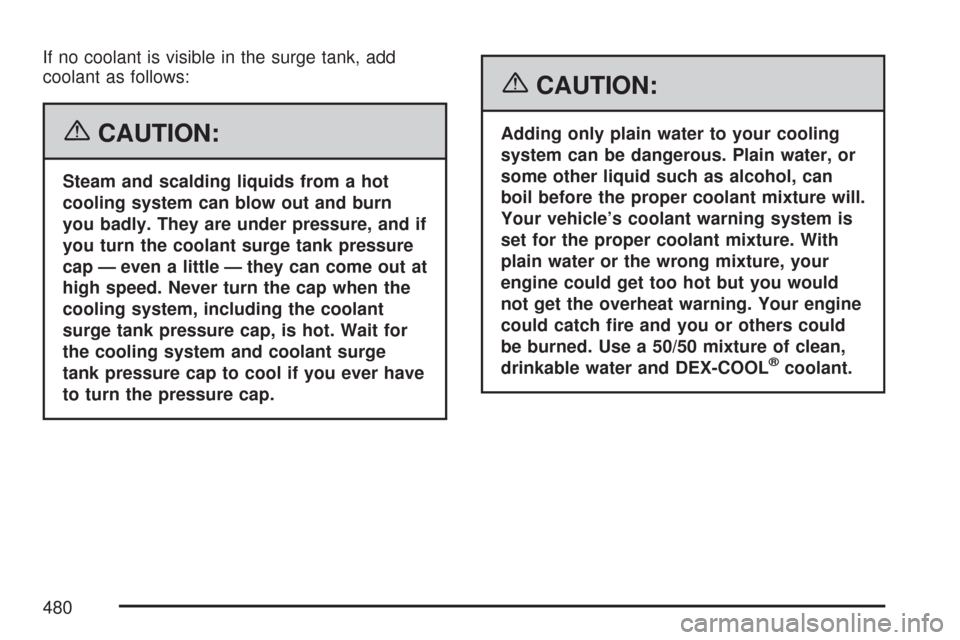
If no coolant is visible in the surge tank, add
coolant as follows:
{CAUTION:
Steam and scalding liquids from a hot
cooling system can blow out and burn
you badly. They are under pressure, and if
you turn the coolant surge tank pressure
cap — even a little — they can come out at
high speed. Never turn the cap when the
cooling system, including the coolant
surge tank pressure cap, is hot. Wait for
the cooling system and coolant surge
tank pressure cap to cool if you ever have
to turn the pressure cap.
{CAUTION:
Adding only plain water to your cooling
system can be dangerous. Plain water, or
some other liquid such as alcohol, can
boil before the proper coolant mixture will.
Your vehicle’s coolant warning system is
set for the proper coolant mixture. With
plain water or the wrong mixture, your
engine could get too hot but you would
not get the overheat warning. Your engine
could catch �re and you or others could
be burned. Use a 50/50 mixture of clean,
drinkable water and DEX-COOL
®coolant.
480
Page 481 of 634
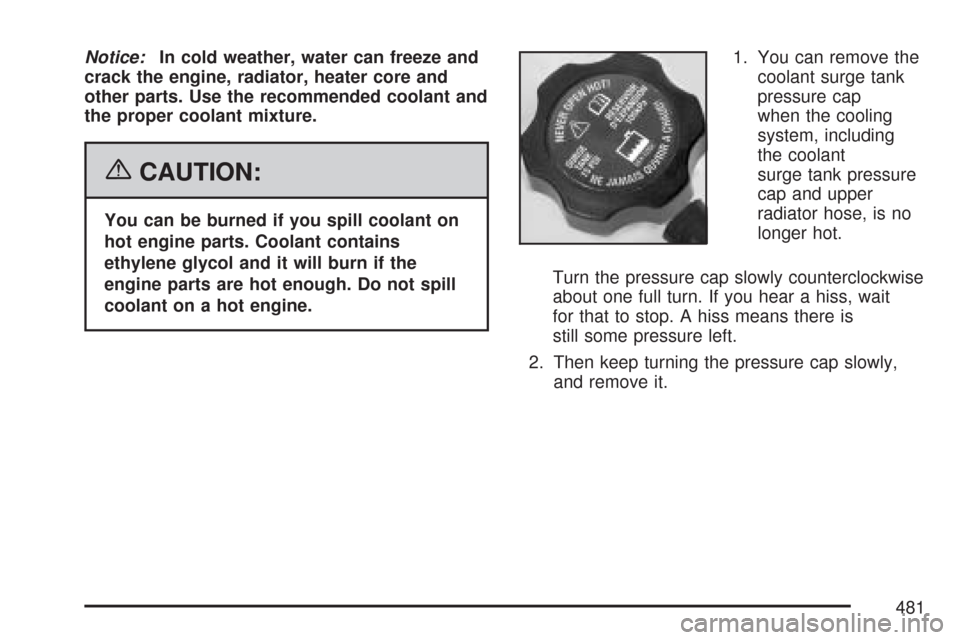
Notice:In cold weather, water can freeze and
crack the engine, radiator, heater core and
other parts. Use the recommended coolant and
the proper coolant mixture.
{CAUTION:
You can be burned if you spill coolant on
hot engine parts. Coolant contains
ethylene glycol and it will burn if the
engine parts are hot enough. Do not spill
coolant on a hot engine.1. You can remove the
coolant surge tank
pressure cap
when the cooling
system, including
the coolant
surge tank pressure
cap and upper
radiator hose, is no
longer hot.
Turn the pressure cap slowly counterclockwise
about one full turn. If you hear a hiss, wait
for that to stop. A hiss means there is
still some pressure left.
2. Then keep turning the pressure cap slowly,
and remove it.
481
Page 482 of 634

3. Fill the coolant surge tank with the proper
mixture, to the FULL COLD mark.4. With the coolant surge tank pressure cap off,
start the engine and let it run until you can
feel the upper radiator hose getting hot. Watch
out for the engine cooling fan.
By this time, the coolant level inside the
coolant surge tank may be lower. If the level
is lower, add more of the proper mixture
to the coolant surge tank until the level
reaches the FULL COLD mark.
482
Page 483 of 634
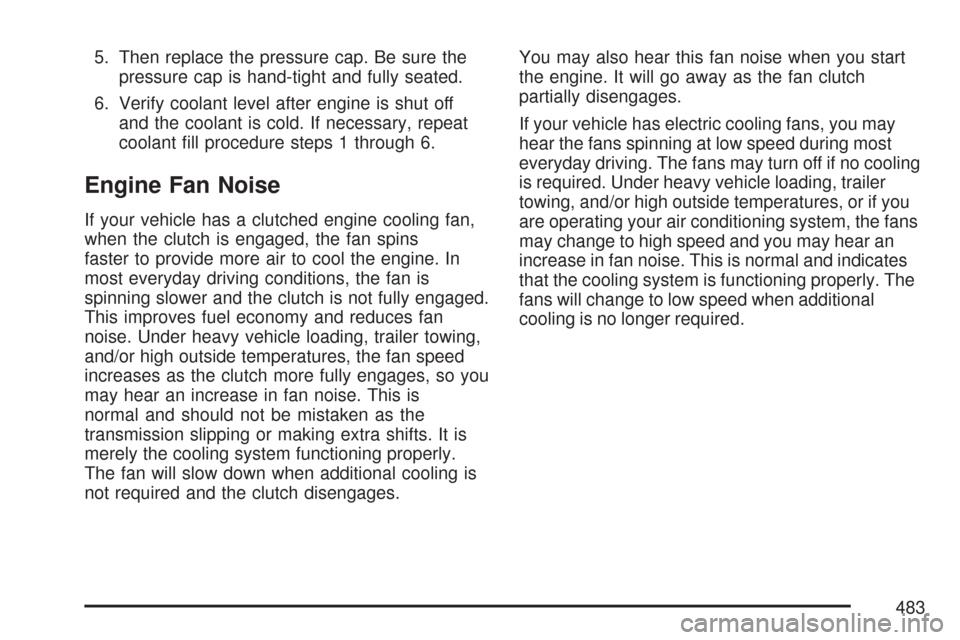
5. Then replace the pressure cap. Be sure the
pressure cap is hand-tight and fully seated.
6. Verify coolant level after engine is shut off
and the coolant is cold. If necessary, repeat
coolant �ll procedure steps 1 through 6.
Engine Fan Noise
If your vehicle has a clutched engine cooling fan,
when the clutch is engaged, the fan spins
faster to provide more air to cool the engine. In
most everyday driving conditions, the fan is
spinning slower and the clutch is not fully engaged.
This improves fuel economy and reduces fan
noise. Under heavy vehicle loading, trailer towing,
and/or high outside temperatures, the fan speed
increases as the clutch more fully engages, so you
may hear an increase in fan noise. This is
normal and should not be mistaken as the
transmission slipping or making extra shifts. It is
merely the cooling system functioning properly.
The fan will slow down when additional cooling is
not required and the clutch disengages.You may also hear this fan noise when you start
the engine. It will go away as the fan clutch
partially disengages.
If your vehicle has electric cooling fans, you may
hear the fans spinning at low speed during most
everyday driving. The fans may turn off if no cooling
is required. Under heavy vehicle loading, trailer
towing, and/or high outside temperatures, or if you
are operating your air conditioning system, the fans
may change to high speed and you may hear an
increase in fan noise. This is normal and indicates
that the cooling system is functioning properly. The
fans will change to low speed when additional
cooling is no longer required.
483
Page 485 of 634
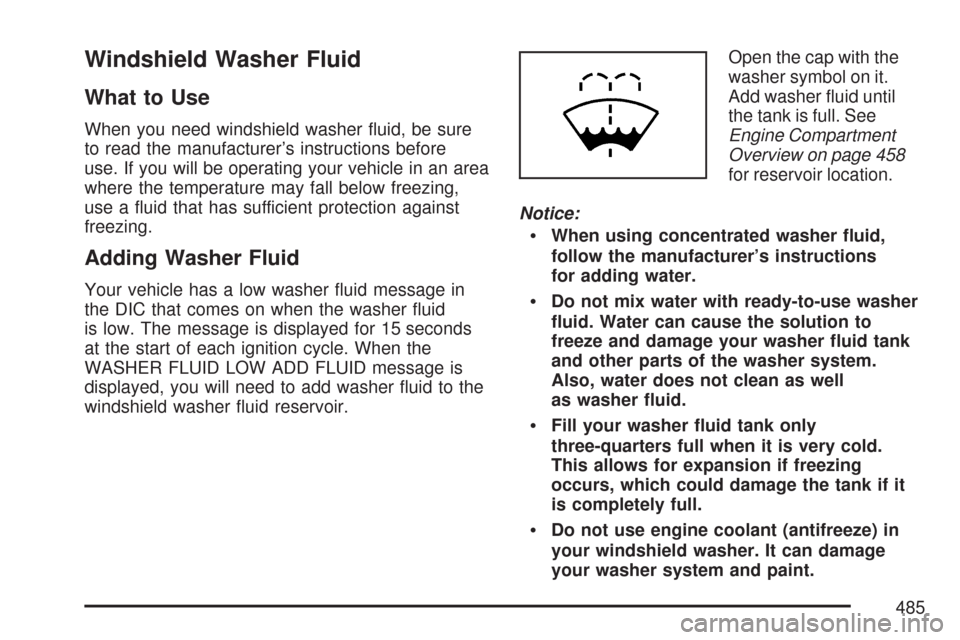
Windshield Washer Fluid
What to Use
When you need windshield washer �uid, be sure
to read the manufacturer’s instructions before
use. If you will be operating your vehicle in an area
where the temperature may fall below freezing,
use a �uid that has sufficient protection against
freezing.
Adding Washer Fluid
Your vehicle has a low washer �uid message in
the DIC that comes on when the washer �uid
is low. The message is displayed for 15 seconds
at the start of each ignition cycle. When the
WASHER FLUID LOW ADD FLUID message is
displayed, you will need to add washer �uid to the
windshield washer �uid reservoir.Open the cap with the
washer symbol on it.
Add washer �uid until
the tank is full. See
Engine Compartment
Overview on page 458
for reservoir location.
Notice:
When using concentrated washer �uid,
follow the manufacturer’s instructions
for adding water.
Do not mix water with ready-to-use washer
�uid. Water can cause the solution to
freeze and damage your washer �uid tank
and other parts of the washer system.
Also, water does not clean as well
as washer �uid.
Fill your washer �uid tank only
three-quarters full when it is very cold.
This allows for expansion if freezing
occurs, which could damage the tank if it
is completely full.
Do not use engine coolant (antifreeze) in
your windshield washer. It can damage
your washer system and paint.
485
Page 573 of 634
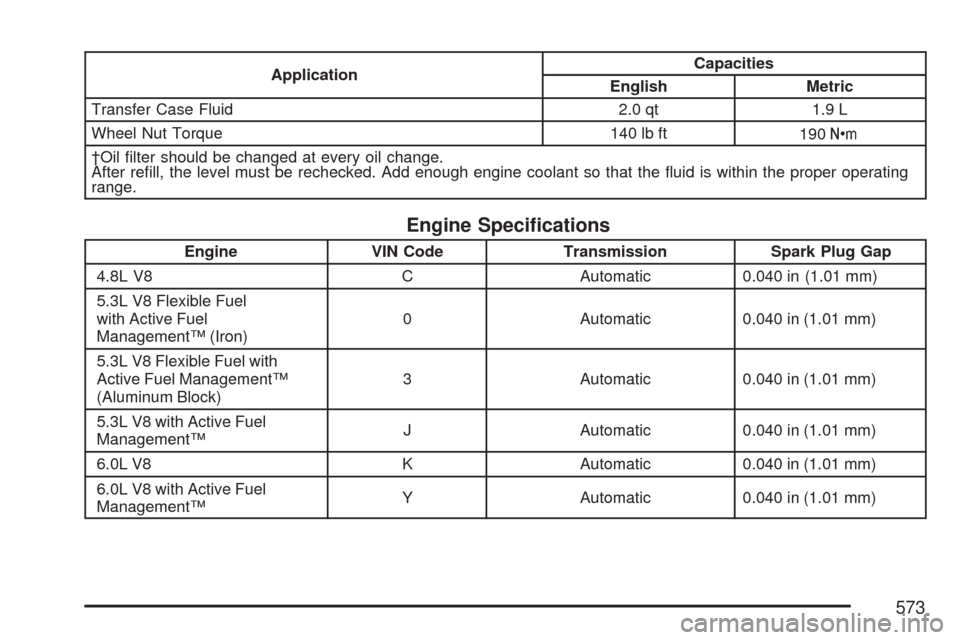
ApplicationCapacities
English Metric
Transfer Case Fluid 2.0 qt 1.9 L
Wheel Nut Torque 140 lb ft
190Y
†Oil �lter should be changed at every oil change.
After re�ll, the level must be rechecked. Add enough engine coolant so that the �uid is within the proper operating
range.
Engine Speci�cations
Engine VIN Code Transmission Spark Plug Gap
4.8L V8 C Automatic 0.040 in (1.01 mm)
5.3L V8 Flexible Fuel
with Active Fuel
Management™ (Iron)0 Automatic 0.040 in (1.01 mm)
5.3L V8 Flexible Fuel with
Active Fuel Management™
(Aluminum Block)3 Automatic 0.040 in (1.01 mm)
5.3L V8 with Active Fuel
Management™J Automatic 0.040 in (1.01 mm)
6.0L V8 K Automatic 0.040 in (1.01 mm)
6.0L V8 with Active Fuel
Management™Y Automatic 0.040 in (1.01 mm)
573
Page 581 of 634

Scheduled Maintenance (cont’d)
Service MaintenanceIMaintenanceII
Check engine coolant and windshield washer �uid levels and add �uid as
needed.••
Perform any needed additional services. See “Additional Required Services” in
this section.••
Inspect suspension and steering components.See footnote (b).•
Inspect engine cooling system.See footnote (c).•
Inspect wiper blades.See footnote (d).•
Inspect restraint system components.See footnote (e).•
Lubricate body components.See footnote (f).•
Check transmission �uid level and add �uid as needed.•
581